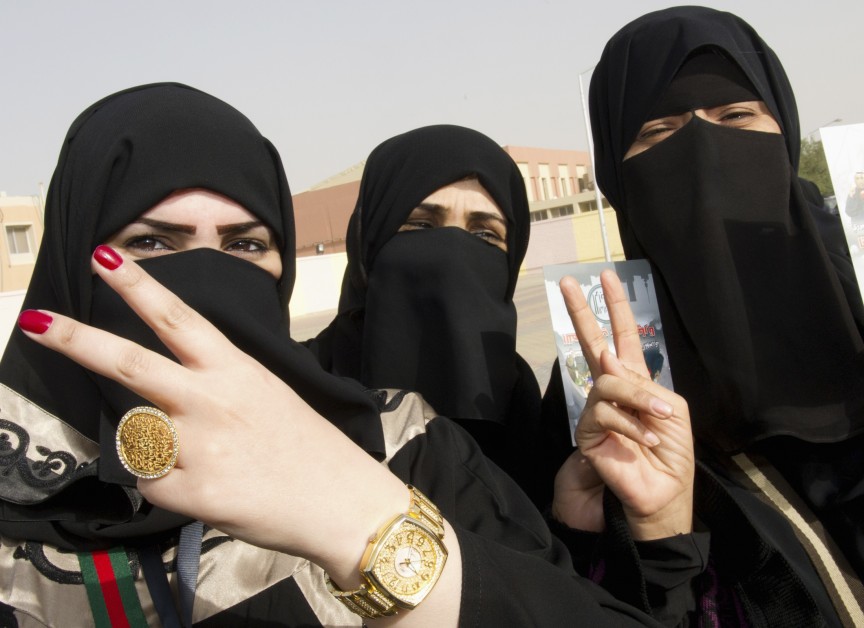Women In These Ten Countries Are More Educated Than Men Yet Do Not Enjoy Equal Rights
The following list features countries in which women now surpass men in university attendance and graduation rates while also drawing attention to the disparity that still exists for women in the labour force around the world.
10. Saudi Arabia
Despite only recently gaining the right to vote, Saudi Arabia's educational system has been progressive towards women's education for a while. The Saudi Embassy reports that there are currently 1 million students enrolled in universities in Saudi Arabia and of that number, over half of attendees are women. A Yale University study reports that women make up almost 60 per cent of those enrolled in university—a highly progressive achievement, considering the fact that Saudi women aren't even allowed to operate a vehicle alone. Despite the fact that a higher percentage of Saudi women are educated compared to Saudi men, women in this country still constitute a very slim minority of the labour force.
9. Argentina
Argentina has had a high female-to-male enrolment ratio in tertiary education for over 15 years. Since the 1990s, the percentage of female enrollment and graduates has been over 50 per cent. Despite this, not only are women are still a minority in the workforce, they also tend to be under-represented in the STEM fields – science, technology, engineering, and mathematics. This matches the global trend of women entering the humanities, social sciences and business fields, and men dominating the STEM fields.
8. United States of America
In the US, women make up 57.4 per cent of all university attendees. Since 2008, the rate of master’s degrees awarded to women has increased by 54 per cent. In 2010, the US department of education noted that women now surpass men in “enrollments at higher-education institutions at every degree level.” Yet, women only hold about 3 percent of the highest positions in corporate America and are still paid less for the same work – an average of 77 cents to every dollar earned by men. The employment rate for women in the US is just above 60 per cent.
yahoo.com7. Brazil
In 2009, women made up 60 percent of university graduates and postgraduates in Brazil according to a report by the Organization for Economic Co-operation and Development (OECD), an international think-tank that works toward advancing economic growth and employment rates globally within 34 countries constituting its members. The employment rate for women in Brazil is slightly over 50 percent but despite the fact that there are more female university graduates than men, women still earn 30 percent less than men for the same work. Of the 594 seats in the Brazilian Congress women occupy only 56.
6. Spain
The Spanish government is quite focused on improving education. For the first few years of the global recession, Spain did not reduce its expenditure on education. With 60% of all graduates and post-graduates being female, their dedication to the quality and quantity of education available is evident. Another key point is that Spanish women with tertiary education earn 89% of what their male counterparts do. This is wage gap is relatively lower than most developed and developing countries.
yahoo.com5. Estonia
While most people haven't heard of Estonia, a Northern European country, they would be even more surprised to know that it has the highest percentage of female graduates of the 34 OECD (Organisation for Economic Co-operation and Development) member countries. With 204 female graduates for every 100 male graduates, women in Estonia tend to acquire more higher and tertiary education than men. Women tend to dominate every educational level, but there are more men in the fields of natural and exact sciences. This tendency to focus on different streams of study isn't decreasing, and that is a concerning fact.
4. Chile
In 2009, women made up almost 60 percent of female graduates and postgraduates in Chile. The female employment rate in Chile is at slightly over 40 percent and this is attributable to a number of factors. A notable contributing cultural factor to women’s absence from the labor force is that in Chile, women must often choose between working or raising a family. The notorious ‘machista’ or male perspective that women should remain at home common in Latin American countries tends to discourage women from joining the labor force, despite their level of education.
3. Iran
In 2003, more than 60 percent of all college attendees in Iran were women. That year, every 6 out of 10 college graduates were women as well. A graduate degree increases an Iranian woman’s chance of joining the labor force by 28 percent but only a quarter of female graduates actually participate in the workforce. This is due to the fact that the country’s strict traditional and religious values continue to stifle women’s independence and often deter their participation in the workforce by offering poor compensation, exhibiting workplace abuse and exploitation, or simply not hiring women.
2. Canada
The Canadian education system has been redesigned to be more hospitable to women and decrease the gender gap that had existed. By the 1990s, the overall gender imbalance tipped in favour of women. Today, over 51 per cent of the Canadian adult population is in possession of a tertiary qualification. Over 62 per cent of all university graduates in Canada are women. Nearly two-thirds of the medical school graduates are women. Canada has one of the highest female employment rates at 70 per cent.
yahoo.com1. Finland
Not only are 80% of women enrolled at a higher education institution, Finnish women also make up over 60% of all university graduates and post-graduates. The Finnish education system also has more opportunities for women in STEM fields. This also helps establish Finland as the best country for female graduates in the OECD countries with a female employment rate of 66%.
While the above statistics may paint a rather pleasing picture, there is a still long way to go for equality in the different fields of education and the workforce
There are many countries where due to cultural and social restrictions, educated women are counter-intuitively becoming homemakers. In countries where women do make up a large portion of the workforce, the glass ceiling still makes it harder for them than their male counterparts.
As no great achievement can exist without its challenges, we must note the threat that exists to women’s education in countries where misogynistic or extremist ideals maintain the counter-progressive outlook that women must remain subservient to men. This is a reality which has proven all too horrifying in the case of over 200 young girls who have been recently abducted in Nigeria for attending school. Their oppressors, the Boko Haram (a name which means, disturbingly, Western Education is a Sin) exist as a mournful reminder that education — that which breeds and nurtures individualism, global consciousness, and personal fruition — can prove a dangerous thing to despotic reigns of power as it counters their stratagems of control.
But despite obstructions, the rise in women pursuing higher education is a pivotal achievement of our era. It’s especially noteworthy when we consider that women in the US were granted the right to vote just less than a hundred years ago, or that in Saudi Arabia, for instance, that right wasn't introduced until 2005. The rapid advancement of women’s rights signifies the import of female leadership in a world hitherto strictly governed by men. Women are now empowering themselves through education, taking hold of all its limitless advantages and keeping a firm grip.









